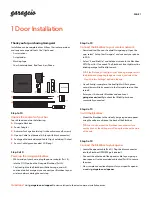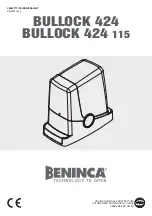
9
ENGLISH
ENGLISH
3.2. INSTALLING THE OPERATOR
1)Dig out a hole for the base plate
as shown in fig. 3.
In order to ensure the correct
engaging of the pinion and
rack, the base plate must be
placed in the position shown in
fig. 4a (right closing) or 4b (left
closing).
N.B. it is advisable to place the base plate on a concrete foundation
at about 50 mm from the ground (fig. 5).
2) Lay the flexible pipes for connection cables between operator,
accessories, and power supply. The flexible pipes must protrude by
approximately 3 cm from the opening on the plate (fig 3).
3) Cement in the plate, ensuring that it is perfectly level.
4) Wait for the concrete to set in the hole.
5) Lay the cables for connection with accessories and power supply.
To facilitate the electrical wiring on the electronic unit, about 30 cm
of cable should come out of the opening on the base plate.
6) Fasten the operator to the base plate by means of the screws and
washers supplied, as shown in fig. 6.
The positioning of the operator is shown
in fig. 5.
Pass the electrical cables through the
relevant opening (fig. 1 - ref. 5) on the base
of the operator.
7)Pass the electrical connection cables
through the relevant opening on the base
of the electronic control unit support (fig.
1 - ref. 3), using the cable clamp supplied.
8) Connect up the cables to the electronic
control unit.
Important: connect up the earth cable
of the system to the position shown in fig. 1 - ref. 12.
Fig. 3
9
50
13
88
14,5÷23
70
(50)
3
Fig. 5
3.3. ASSEMBLING THE RACK
1) Fit the rack by means of the screws TE 8 x 25 and the spacers provided,
as shown in figure 7.
To avoid welding to the gate, galvanized passing spacers with screws
TE 8 x 50 are provided.
N.B. it is advisable to tighten the rack fixing screws at the top of the
slot. This allows the rack to be raised if, with time, the gate tends to
sink.
2) Release the operator (see paragraph
13).
3) Slide the gate leaf open, by hand.
4) Place the first section of the rack on the
pinion, aligning the latter with the first
spacer (fig. 8).
5) Fix the rack section to the leaf by means
of a clamp (fig. 8).
6) Slide the gate leaf by hand towards its
closed position, until it is in line with the third spacer on the rack, and
spot weld the spacer in position.
7) Completely weld the three spacers to the gate.
To fasten the other rack sections needed to reach the position of
complete closing, proceed as follows:
8) Line up another rack section to the last one fixed to the gate. Use a
section of rack of about 150 mm and ensure that the teeth are
correctly spaced (fig. 9).
9) Slide the gate by hand towards its closed position until the third
spacer of the section to be fastened is aligned with the pinion (fig.
9).
N.B. ensure that all the rack sections are correctly centered on the
pinion teeth. If not, adjust the position of the operator.
10)Weld the three spacers of the section (fig. 9).
Caution:
a)
do not weld the rack sections to the spacers or to each other;
b)
do not use grease or other lubricants on the pinion and rack.
11)To obtain a correct slack between the pinion and rack, lower the
operator by 1.5 mm, by means of the support nuts of the base plate
(fig. 10).
When this adjustment has been completed, tighten the screws that
fasten the operator.
Caution: If the gate is new, check the slack (fig. 11) after a few
months.
12)Manually check whether the gate can open completely and the
movement of the leaf is smooth and even, over its entire travel.
Fig. 6
Fig. 7
Fig. 8
Fig. 9
1.5
Fig. 10
Fig. 11
70 72
÷
0 50
÷
200
90
°
70 72
÷
0 50
÷
120
90
°
Fig. 4b
Fig. 4a



























